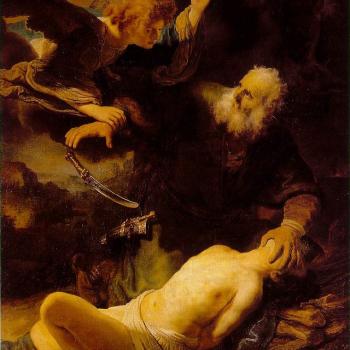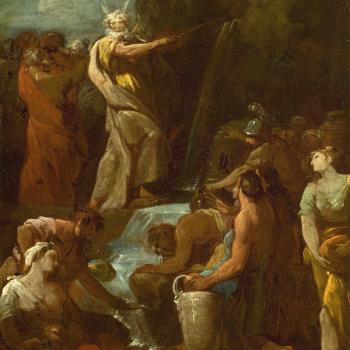This is Chapter Three of my book, The Word Set in Stone: How Archaeology, Science, and History Back up the Bible (Catholic Answers Press, March 15, 2023: see further book and purchase information). Bible passages: RSV.
*****
Then the Lord appeared to Abram and said,
“To your descendants I will give this land.”
—GENESIS 12:7
We can’t find out much (if anything) specifically about the patriarch Abraham, revered in Christianity, Judaism, and Islam alike as “the father of faith.” Archaeologists have not yet found physical, or “hard,” evidence that he existed.
Nevertheless, if the purported accounts of Abraham in Genesis are verified as accurate, according to what we know from history and archaeology, then we have an objective and rational basis for believing that Abraham did exist in history, as opposed to being merely fictional or mythological (like Heracles of Greek mythology).
Particularly—as I will primarily contend in this chapter— we can offer strong archaeological evidence that cities and regions mentioned in the Bible as having been visited or lived in by Abraham did indeed exist before and during the time period involved. If they didn’t exist then, it would clearly present a problem.
Such verifications don’t prove the Bible’s inspiration, but they do support its historical accuracy and highly suggest that many biblical skeptics have gone too far in their negative or agnostic opinions.
According to the Bible, Abraham was a man who took many journeys. Joshua 24:2–3 states,
Thus says the Lord, the God of Israel . . . “I took your father Abraham from beyond the River and led him through all the land of Canaan, and made his offspring many.”
The usual or “standard” view is that Abraham came from Ur of the Chaldeans (see Gen. 11:27–28, 31), which is close to the Persian Gulf, west of the Euphrates, in southern Mesopotamia (current-day Iraq). Some biblical evidences regarding Abraham’s journey to Canaan, however, suggest another city: Urfa (also known as Sanliurfa and, in ancient times, Edessa) in present-day Turkey (southeastern Anatolian region).
Gary Rendsburg, professor of Jewish history in the Department of Jewish Studies at Rutgers University, makes the case for Urfa being the biblical Ur of the Chaldeans or Chaldees:
A serious geographical problem plagues the story: a journey from Ur to Canaan would not pass through Harran. . . .
A more attractive suggestion is that Abraham’s hometown is the city of Ur in northern Mesopotamia = modern-day Urfa in southeastern Turkey, 44 km [27 miles] north of Harran. Most likely, this city is the one mentioned as Ura in cuneiform tablets from Ugarit (fourteenth-thirteenth centuries BCE), where it is associated with the Hittite realm. A journey from Urfa to Canaan would indeed pass directly through Harran.
Local (Turkish) Jewish, Christian, and Muslim tradition identifies this city as biblical Ur, the birthplace of Abraham. In fact, this notion was commonly accepted in nineteenth-century biblical scholarship. [42]
Cyrus H. Gordon, professor of Hebraic studies at New York University, adds,
The biblical evidence is by itself conclusive in placing Ur of the Chaldees in the Urfa-Haran region of south central Turkey, near the Syrian border, rather than in southern Mesopotamia . . .
Genesis 24:4, Genesis 24:7, Genesis 24:10, and Genesis 24:29 tells us that Abraham’s birthplace was in Aram-Naharayim where Laban lived. [43]
The journey from Ur to Haran (also spelled “Harran”— see Gen. 12:4–5; Acts 7:3–4), undertaken by Abraham, was 27 miles. M. Bözdeniza et al. noted that “the known written documents about Harran indicate that its history goes as far back as 2500 B.C.” [44] Tamara M. Green placed the city’s origin at around 2000 B.C. and observed that it was “founded as a merchant outpost by Ur.” [45] She noted that “the abundance of goods that passed through the area must have proved a temptation, for raids upon the caravan were frequent.” Either date is earlier than the estimated time of Abraham’s birth: around 1880–1860 B.C., according to the copiously researched scholarly determinations of Egyptologist Kenneth A. Kitchen. [46] Haran was ideally located on a trade route between the Mediterranean and the plains of the Tigris River.
Genesis 12:6 Abram passed through the land to the place at Shechem, to the oak of Moreh. At that time the Canaanites were in the land (see also 33:18).
Archaeology informs us that Shechem was settled (or resettled) before Abraham was born—“in around 1900” B.C.—and that it had “a two-hundred-year period of prominence as a city-state, covering the centuries from 1750 to 1540” B.C. [47] David G. Hansen observed,
Archaeological investigations have corroborated much of what the Bible has to say about Shechem’s physical and cultural aspects. Archaeology has confirmed Shechem’s location, its history, and many biblical details. . . .
In the original Hebrew, the word translated in our English Bible as “city” meant a permanent, walled settlement. . . . Genesis 34:20 and 24 report that Shechem had a city gate; therefore it was fortified. [48]
The Bible refers to Abraham dwelling “by the oaks of Mamre . . . at Hebron” (Gen. 13:18; see also 14:13, 18:1, 35:27), and also to the burial of his wife Sarah there (23:2, 19). Archaeologists Avraham Negev and Shimon Gibson provide the evidence for Hebron’s existence during Abraham’s lifetime:
The earliest ancient settlement was established . . . during Early Bronze III [2700–2200 B.C.]. . . . This city was destroyed in a substantial conflagration. Not long afterwards and the same period the city was built anew. . . .
Following a period of abandonment, settlement of the site was renewed in Middle Bronze IIB [1750–1650 B.C.]. [49]
A 2018 article on the city [50] at Hebron.org (including a video) notes the discovery in that year of stairs (recently opened to the public) from the time of Abraham:
Dr. Emmanual Eisenberg of the Israel Antiquities Authority led the dig in Tel Hevron. . . . In what is today’s Admot Yishai neighborhood, near the Tomb of Jesse and Ruth is a flight of stairs, over 4,000 years old, leading from the valley below into the ancient city of Hebron.
Another location that the Bible claims Abraham visited and lived in is Beersheba (Gen. 21:14,29–33; 22:19). Biblical scholar John J. Bimson noted about it:
Sarna has argued . . . “The biblical passages refer only to a well and a cultic site. . . . No king or ruler is mentioned, and no patriarch ever has dealings with the inhabitants of Beersheba.” . . . In 1967, Aharoni held the view that the absence of early archaeological evidence does not contradict the patriarchal narratives, which, he then suggested, have only the area of Beersheba in mind, not a town. [51]
The biblical data appear perfectly consistent with this scenario. Beersheba is mentioned eleven times in Genesis in the RSV. None of the passages requires the interpretation of even a town, let alone a city. The first mention, in Abraham’s time (Gen. 21:14), refers to “the wilderness of Beersheba.”
Genesis 14:17–18 After his return from the defeat of Ched-or-laomer and the kings who were with him, the king of Sodom went out to meet him at the Valley of Shaveh (that is, the King’s Valley). And Melchizedek king of Salem brought out bread and wine; he was priest of God Most High.
These two things have to do with Jerusalem. Most scholars think Salem was a name for ancient Jerusalem (one of several). Mt. Moriah is the spot in Jerusalem (currently the Temple Mount) where Solomon’s temple was built some 600–700 years after Abraham was willing to sacrifice his son there. The traditional spot is currently covered by the Islamic Dome of the Rock.
Many seem to think that Jerusalem began, or first became a significant city, at the time David became king (c. 1000 B.C.). This is untrue. It was already very old by that time. Archaeological evidence exists for a settlement in the area as early as 4500–3500 B.C. The first mention of the city that we know of occurred around 2000 B.C. in the Egyptian Execration Texts [52] from the Middle Kingdom (2040 to 1782 B.C.). Massive walls (with four- and five-ton boulders) 26 feet high were built in Jerusalem by the seventeenth century B.C.—some 600 years before King David. The famous Ebla discoveries (including 1,800 complete clay tablets), discovered in Syria in 1974–1975, date to between approximately 2500–2250 B.C. They refer to the name of ancient Jerusalem as Ye-ru-sa-lu-um. [53]
Thus, an abundance of undeniable evidence exists showing that Abraham’s meeting with Melchizedek is a plausible event, given the known chronology of ancient Jerusalem. Nothing that we know would make such a meeting at that time and place impossible. In other words, the biblical account can’t be casually ruled out as historically inaccurate or “mythical,” as not a few biblical skeptics or archaeological minimalists would claim.
FOOTNOTES
42 Gary Rendsburg, “Ur Kasdim: Where Is Abraham’s Birthplace?,” Torah.com, 2019.
43 Cyrus H. Gordon, “Where Is Abraham’s Ur?,” Biblical Archaeology Review 3.2 (1977): 20–21, 52.
44 M. Bözdeniza et al, “Vernacular domed houses of Harran, Turkey,” Habitat International, vol. 22, no. 4 (December 1998), 477–485. Citation from page 478.
45 Tamara M. Green, The City of the Moon God: Religious Traditions of Harran (Leiden, Netherlands: Brill, 1992), 19.
46 Kenneth A. Kitchen, On the Reliability of the Old Testament (Grand Rapids and Cambridge: Wm. B. Eerdmans Publishing, 2003), 359.
47 See Ephraim Stern (ed.), The New Encyclopedia of Archaeological Excavations in the Holy Land, Vol. 4 (Carta, Jerusalem: The Israel Exploration Society, 1993); “Shechem,” 1,345–1,353. Citations from p. 1,347 and p. 1,352.
48 David G. Hansen, “Shechem: Its Archaeological and Contextual Significance,” Bible and Spade (Spring 2005).
49 Avraham Negev and Shimon Gibson, Archaeological Encyclopedia of the Holy Land (New York: Continuum, 2001), 224.
50 “The History of the 4,000-Year-Old Steps in Hebron” (October 26, 2018).
51 John J. Bimson, “Archaeological Data and the Dating of the Patriarchs,” chapter in A.R. Millard & D.J. Wiseman (ed.), Essays on the Patriarchal Narratives (Leicester, UK: InterVarsity Press, 1980), 59–92 (citation from pp. 75–76).
52 See “The Execration Texts,” City of David: Ancient Jerusalem.
53 For this and related information about pre-Davidic Jerusalem, see “Ancient Jerusalem.”
***
Practical Matters: Perhaps some of my 4,000+ free online articles (the most comprehensive “one-stop” Catholic apologetics site) or fifty-one books have helped you (by God’s grace) to decide to become Catholic or to return to the Church, or better understand some doctrines and why we believe them.
Or you may believe my work is worthy to support for the purpose of apologetics and evangelism in general. If so, please seriously consider a much-needed financial contribution. I’m always in need of more funds: especially monthly support. “The laborer is worthy of his wages” (1 Tim 5:18, NKJV). 1 December 2021 was my 20th anniversary as a full-time Catholic apologist, and February 2022 marked the 25th anniversary of my blog.
PayPal donations are the easiest: just send to my email address: apologistdave@gmail.com. You’ll see the term “Catholic Used Book Service”, which is my old side-business. To learn about the different methods of contributing, including 100% tax deduction, etc., see my page: About Catholic Apologist Dave Armstrong / Donation Information. Thanks a million from the bottom of my heart!
***
Summary: Chapter Three of my book, The Word Set in Stone (March 15, 2023) surveys the archaeological evidence that is consistent with the accounts of Abraham in the Bible.


















